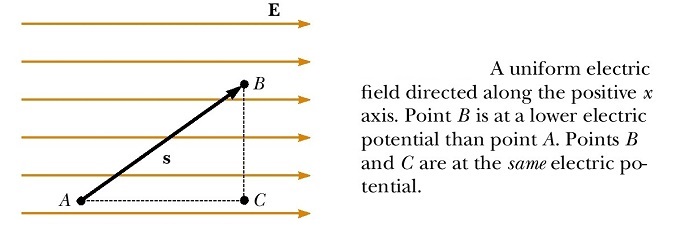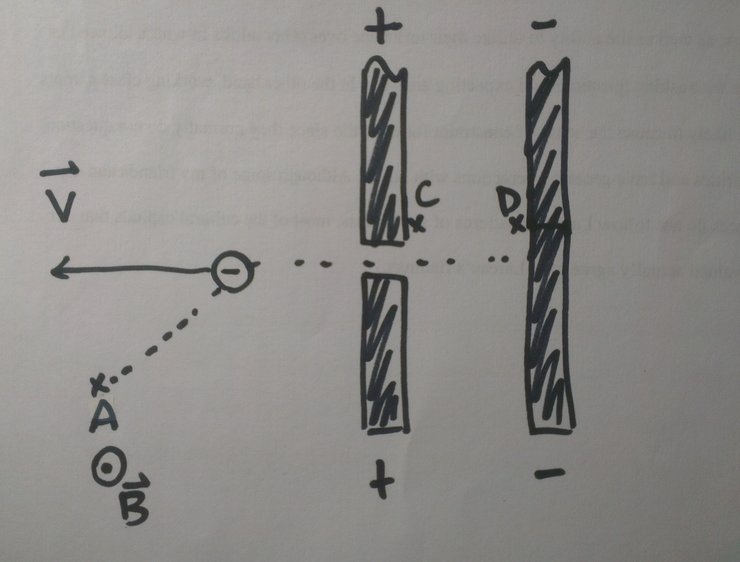Sign of Potential Difference: Difference between revisions
| Line 62: | Line 62: | ||
==Connectedness== | ==Connectedness== | ||
-Potential difference is connected to the concept of transmembrane potential which I am interested in. Potential difference between the outside and the inside of the cell membrane acts as a battery and provides important functions for us. The ion channels and ion pump proteins that are imbedded in the membrane | -Potential difference is connected to the concept of transmembrane potential which I am interested in. Potential difference between the outside and the inside of the cell membrane acts as a battery and provides important functions for us. The ion channels and ion pump proteins that are imbedded in the membrane allow ions to move across the membrane and create concentration gradients, which then create a potential difference that provides power to allow the transmission of the electric signals, such as those in our neurons and muscle cells. By opening and closing the ion channel, the signal is passed down to the next channels due to the change in potential. A brief video on this can be found [https://www.youtube.com/watch?v=Xiza8nLww-I here]. | ||
-As a Biomedical Engineering major, the concept of potential difference can be applied to the study of electric stimulation of cells. By causing the change in potential across the cells, voltage-dependent ion channels can be affected. From this concept, we can develop devices that are responsible for the signals of cells, such as a defibrillator. | -As a Biomedical Engineering major, the concept of potential difference can be applied to the study of electric stimulation of cells. By causing the change in potential across the cells, voltage-dependent ion channels can be affected. From this concept, we can develop devices that are responsible for the signals of cells, such as a defibrillator. | ||
Revision as of 23:07, 23 November 2015
Claimed by Wendy Sheu
This page provides an explanation to determine the sign of potential difference in which the sign shows whether energy is lost or gained by a moving charged particle.
The Main Idea
By determining the direction of path relative to the direction of electric field, the sign of potential difference can then be determined. The sign of potential difference then shows if there is an increase or a decrease in potential energy, as well as kinetic energy.
A Mathematical Model
Potential difference is the product of the electric field [math]\displaystyle{ \vec{E} }[/math] and the relative path [math]\displaystyle{ \Delta x }[/math]:
- [math]\displaystyle{ \Delta V }[/math] = -[math]\displaystyle{ \vec{E} }[/math]●[math]\displaystyle{ \Delta \vec{x} }[/math]
Sign of [math]\displaystyle{ \Delta V }[/math]
- [math]\displaystyle{ \Delta x }[/math] in the direction of [math]\displaystyle{ \vec{E} }[/math]: negative
- [math]\displaystyle{ \Delta x }[/math] in the opposite direction of [math]\displaystyle{ \vec{E} }[/math]: positvie
- [math]\displaystyle{ \Delta x }[/math] is perpendicular to the direction of [math]\displaystyle{ \vec{E} }[/math]: [math]\displaystyle{ \Delta V }[/math]=0
A Computational Model
Examples
Simple
If [math]\displaystyle{ x_i }[/math] = <3,0,0> m, [math]\displaystyle{ x_f }[/math] = <5,0,0> m, and [math]\displaystyle{ \vec{E} }[/math] = <100,0,0> V/m:
- (Path is in the same direction as the electric field.)
- [math]\displaystyle{ \Delta \vec{x} }[/math] = [math]\displaystyle{ x_f }[/math] - [math]\displaystyle{ x_i }[/math] = <5,0,0> - <3,0,0> = <2,0,0> m
- [math]\displaystyle{ \Delta V }[/math] = -[math]\displaystyle{ \vec{E} }[/math]●[math]\displaystyle{ \Delta \vec{x} }[/math] = -<100,0,0>●<2,0,0> = -200 V
If [math]\displaystyle{ x_i }[/math] = <5,0,0> m, [math]\displaystyle{ x_f }[/math] = <3,0,0> m, and [math]\displaystyle{ \vec{E} }[/math] = <100,0,0> V/m:
- (Path is in the opposite direction of the electric field.)
- [math]\displaystyle{ \Delta \vec{x} }[/math] = [math]\displaystyle{ x_f }[/math] - [math]\displaystyle{ x_i }[/math] = <3,0,0> - <5,0,0> = <-2,0,0> m
- [math]\displaystyle{ \Delta V }[/math] = -[math]\displaystyle{ \vec{E} }[/math]●[math]\displaystyle{ \Delta \vec{x} }[/math] = -<100,0,0>●<-2,0,0> = 200 V
If [math]\displaystyle{ x_i }[/math] = <3,0,0> m, [math]\displaystyle{ x_f }[/math] = <5,0,0> m, and [math]\displaystyle{ \vec{E} }[/math] = <0,100,0> V/m:
- (Path is perpendicular to the electric field.)
- [math]\displaystyle{ \Delta \vec{x} }[/math] = [math]\displaystyle{ x_f }[/math] - [math]\displaystyle{ x_i }[/math] = <5,0,0> - <3,0,0> = <2,0,0> m
- [math]\displaystyle{ \Delta V }[/math] = -[math]\displaystyle{ \vec{E} }[/math]●[math]\displaystyle{ \Delta \vec{x} }[/math] = -<100,0,0>●<0,2,0> = 0 V
Middling
If Location A = <3,0,0>, Location B = <5,-3,1> and E = <100, 100, 0>
- [math]\displaystyle{ \Delta \vec{x} }[/math] = [math]\displaystyle{ x_f }[/math] - [math]\displaystyle{ x_i }[/math] = <5,-3,1> - <3,0,0> = <2,-3,1> m
- [math]\displaystyle{ \Delta V }[/math] = -[math]\displaystyle{ \vec{E} }[/math]●[math]\displaystyle{ \Delta \vec{x} }[/math] = -<100,100,0>●<2,-3,1> = <-200,300,0> V
- In x-direction, there is an electric field in the same direction as the path, so the potential difference is negative.
- In y-direction, there is an electric field in the opposite direction of the path, so the potential difference is positive.
- In z-direction, since the electric field is perpendicular to the path, so the potential difference is zero.
Difficult
An electron starts from rest near one plate of a charged capacitor, and travels in the -x direction, passing through a tiny hole in the capacitor. At the instant shown in the diagram, the electron is at the origin. At this moment the magnetic field at location A, due to the electron, is out of the page. The left plate of the capacitor is positive, and the right plate is positive. What would be the potential difference from location D to location C? What is the sign of it?
- [math]\displaystyle{ \Delta V }[/math] = -[math]\displaystyle{ \vec{E} }[/math]●[math]\displaystyle{ \Delta \vec{x} }[/math] = [math]\displaystyle{ \Delta V_C - \Delta V_D }[/math]
- By conservation of energy, potential energy = kinetic energy
- [math]\displaystyle{ q (\Delta V_C - \Delta V_D) }[/math] = [math]\displaystyle{ 1/2mv^2 }[/math], where [math]\displaystyle{ q }[/math] is the charge of electron, [math]\displaystyle{ m }[/math] is the mass of electron, and [math]\displaystyle{ v }[/math] is the velocity that the electron is traveling.
- [math]\displaystyle{ \Delta V_C - \Delta V_D }[/math] = [math]\displaystyle{ 1/2mv^2/q }[/math]
- The sign is positive since the electric field is going to the +x direction, whereas the electron is moving to the -x direction.
Connectedness
-Potential difference is connected to the concept of transmembrane potential which I am interested in. Potential difference between the outside and the inside of the cell membrane acts as a battery and provides important functions for us. The ion channels and ion pump proteins that are imbedded in the membrane allow ions to move across the membrane and create concentration gradients, which then create a potential difference that provides power to allow the transmission of the electric signals, such as those in our neurons and muscle cells. By opening and closing the ion channel, the signal is passed down to the next channels due to the change in potential. A brief video on this can be found here.
-As a Biomedical Engineering major, the concept of potential difference can be applied to the study of electric stimulation of cells. By causing the change in potential across the cells, voltage-dependent ion channels can be affected. From this concept, we can develop devices that are responsible for the signals of cells, such as a defibrillator.
-Industrial applications based on potential difference are again the devices that are used to affect the ion channels in which to allow activation or recovery of cell signals.
History
Most countries in the world and Europe use a voltage from 220 volts to 240 volts. In the other hand, most countries in the Americas and Japan use a voltage from 100 volts to 127 volts. In 19th century, Nikola Tesla determined that 60 Hz was the best frequency and preferred 240 volts for AC power while Thomas Edison preferred 110 volts. AEG, a German company, decided to build the first European generating facility with 50 Hz because 60 was dissatisfied by the sequence of the metric standard unit, and this standard was then spread out. Europe used to use 120 volts, but it was determined that higher voltage should be used to "get more power with less losses and voltage drop from the same copper wire diameter." The U.S did not end up changing because the cost for all the replacement was too high; fridge and washing-machine were already common in an average U.S. household in the 50s-60s but not in Europe. Then, problems like light bulbs burning out quickly led to the splitting voltage into two 120 volts.
See also
-Kinetic Energy and Potential Energy: The sign of potential difference shows whether energy is gained or lost from a moving particle. When there is an increase in potential energy [math]\displaystyle{ q \Delta V }[/math], there is a decrease in kinetic energy, and vice-versa.
-Polarization and Electric Field: Potential difference can be caused by polarization in which the charged particles move in different paths affect each other.
-Simple Circuits: Topics under simple circuits are mostly related to potential difference since batteries are involved, such as in RC circuit, Loop rule, and current.
Further reading
electric potential and capacitance
Matter & Interactions, Vol. II: Electric and Magnetic Interactions, 4nd Edition by R. Chabay & B.Sherwood (John Wiley & Sons 2015) (pp.635-637)
Dorf, Richard C. Sensors, Nanoscience, Biomedical Engineering, and Instruments. 3rd ed. N.p.: Taylor & Francis, 2006. Print.
External links
References
Matter & Interactions, Vol. II: Electric and Magnetic Interactions, 4nd Edition by R. Chabay & B.Sherwood (John Wiley & Sons 2015) (pp.635-637)
SB1, Knisley, Blitchington TF, Hill BC, Grant AO, Smith WM, Pilkington TC, and Ideker RE. "Result Filters." National Center for Biotechnology Information. U.S. National Library of Medicine, Feb. 1993. Web. 22 Nov. 2015.
potential-difference-in-uniform-electric-field. Kshitij Education India. 22 Nov. 2015.
"Why Isn't There A standard Voltage around the World?" World Standards, 16 Aug. 2015. Web. 23 Nov. 2015.

